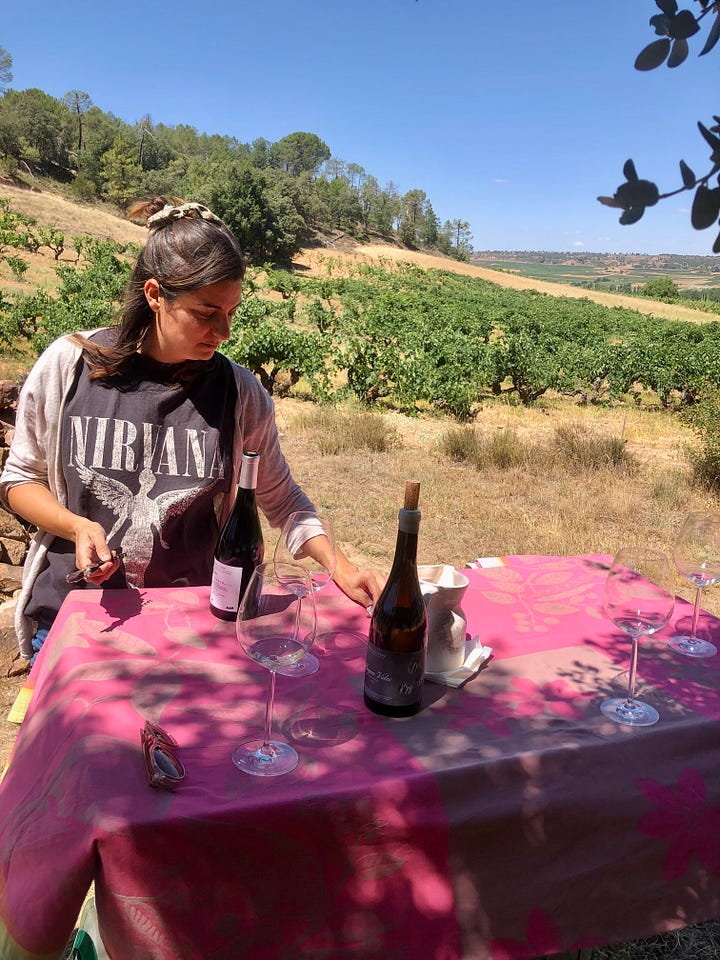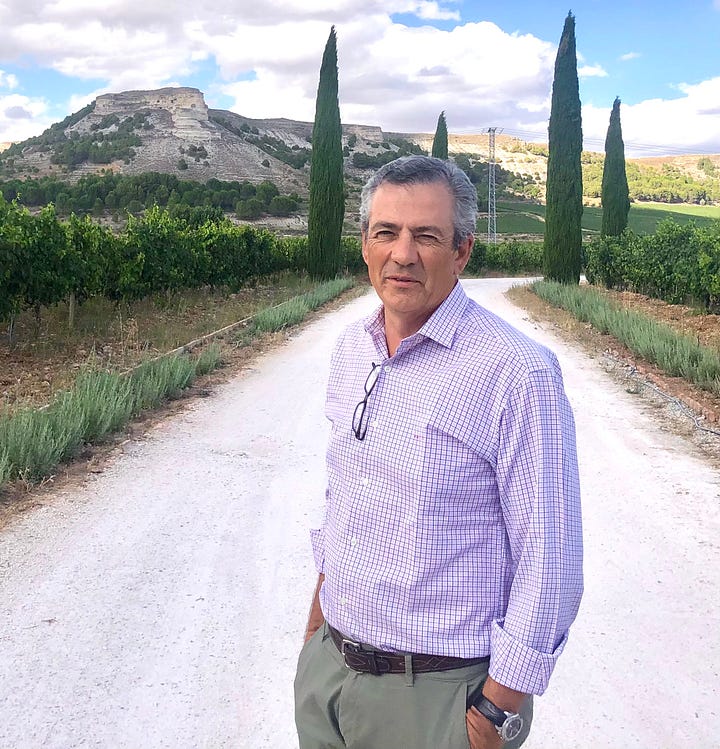Ribera del Duero's new wave
Exploring fresh approaches in Spain's premier wine region. Plus: what I've been drinking this week


TASTING with Andrea Sanz and Pablo Arranz among their vines on a beautiful August day, you could forget that we’re in Spain’s premium wine region, Ribera del Duero.
Sanz and Arranz’s Magna Vides bodega is small scale (making around 20,000 bottles a year) and their style informal: Sanz, in Nirvana T-shirt and ripped jeans, pours the wines in glasses set out on a folding table under the shade of a tree. We arrived in Sanz’s dusty family car on dirt roads; at the end of the tasting, she and her husband excuse themselves to relieve childcare for their six year-old son.
It’s a far cry from the mansions of the grand Rioja bodegas in Haro, the other contender for the title of Spain’s most serious red wine. It feels even further from the high-end Bordeaux châteaux that Rioja first started imitating in the mid nineteenth century. But Magna Vides are among the stars in this surprisingly young region.
Despite the status Ribera now enjoys, it officially became a Denominación de Origen only in 1982. Spain’s most famous estate, Vega Sicilia, had been making wine here since 1864, but until the late 1970s had been joined by only a handful of other producers.
It’s not an easy place to grow grapes. Sitting at 700-1,000 metres on the central Spanish meseta (highland plateau), Ribera labours under an unforgiving climate. While temperatures can drop to -20°C in January, frost in April is normal and can hit as late as mid-May. Yet in July, the mercury can rise to 42°C.
So while some farmers traditionally grew grapes for their own consumption, most cultivated other crops for their living. Javier Bohórquez says his land was typical: when he first bought here in 1999, these fields were sugar beet. But after the 1982 vintage attracted US wine critic Robert Parker’s praise, the boom was soon under way, intensifying in the 1990s. By the time Bohórquez arrived, there were already almost 100 producers. Now there are 325.
The seeds of the newer era in Ribera – which British wine critic Tim Atkin MW dates to 2010 and after – were sown then. When the denominación was founded, Ribera had adopted the Rioja system of classification according to the wine’s length of time in oak barrels – Joven, Crianza, Reserva, Gran Reserva: really as a marker that the region could challenge Rioja at its own game. Producers thereby imported the faults of the Rioja system: an over-emphasis on oak, and a relative lack of interest in terroir – despite significant differences between plots on different soils and at different altitudes, or for instance between the cooler north-facing banks of the river Duero and the slopes facing south.
Thus many new-wave producers today – Magna Vides included – do not use the Joven/Crianza classifications, even if their wines have spent time in wood. With or without oak, their reds – mostly made from Tempranillo, or Tinto Fino/Tinta del País, as it’s known locally – tend to be fresher. And they show much more emphasis on terroir – which vineyard on which hillside the grapes came from.
Pablo Arranz’s father started here as a weekend project in 1999 (his own father had cultivated half a hectare of vines here.) Arranz and his wife Andrea moved here from Madrid in 2005 and started producing wine in 2011. They have always had a strongly organic ethos, even though their vines remain uncertified: “it’s a crime for us, to use chemical sprays”, says Arranz. They are now thinking long term in terms of dry farming.
That is one challenge of the future: with climate change, water can now be a problem here, as Noelia Callejo explained surveying her nearby vineyards. This year there was no rain from February to June. Nevertheless, because of the breezes and sunshine, she says, “It’s so easy to be organic here”. That is part of the change of approach that she and her siblings brought to the bodega founded by their father Félix in 1989.
“When I came back [from training in California and Argentina], I realised the potential we had here,” says Callejo. “But we had to start a journey back to our origins” – looking afresh at the terroir and how to get the best out of each plot, using organic cultivation. As a result, what was then their poorest vineyard, cool Montecillo up at 910 metres, is now the best, through careful tending and attention to factors such as canopy management.
Such developments were on show at Tim Atkin MW’s recent tasting in London of the 100 top-rated Riberas from his most recent report on the region. And one of the exciting things about Ribera now is the range of styles.
Thus Magna Vides’s Bancales del Sardal 2021, incorporating 25% of local white grape Albillo Mayor, was fresh, elegant and beautifully balanced (I had loved the 2020 in the vineyard.) Bohórquez’s Reserva 2018 is in some ways more traditional – even though it includes 10 per cent Cabernet Sauvignon and five per cent Merlot – yet it’s perfumed, savoury and balanced. And Callejo’s top cuvée, Félix Callejo 2021, with just 3,000 bottles made, mostly from the Montecillo vineyard, uses more oak: it’s already beautifully integrated, with sweet and complex fruit, but will be even better in three or four years.
The next 40 years in Ribera could well bring changes as big as those of the past 40. Climate change promises to be a challenge – as in so many other vineyards. But for the moment at least, we should enjoy the pace of innovation in Europe’s youngest fine wine region.
What I’ve been drinking this week
Paolo Conterno “A Mont” Langhe Nebbiolo, 2019 - sweet, perfumed fruit with a backbone: more approachable and better value than any Barolo (2019 now N/A; the Wine Society have the 2020, £18.50.)
Kokotos Heliogenesis Malagousia 2022, Attica - classic Malagousia, lush tropical fruit undercut with acidity. An irresistible Greek white (Wine Society, £14.95.)
Domaine St Antonin 2019, Plan de Dieu, Côtes-du-Rhône Villages – had I known that this wine was 15.5% alcohol, I wouldn’t have bought it (it was listed en primeur as being 14.5%.) I find it unbalanced. No great surprise that Robert Parker gave it 92 points: it’s rich, chocolatey and just very big. But if you can taste the alcohol like you can here, that’s too big (was Wine Society en primeur, £14.87, now N/A UK; Carringtons Wines have the 2020 and xtraWine have the 2021: from £20.)
Transparency disclosure: I consider Tim Atkin a friend a write a bi-monthly column for his website. I tasted at Magna Vides, Bodegas Félix Callejo and Bodegas Bohórquez in August 2023 as a guest of the owners.



